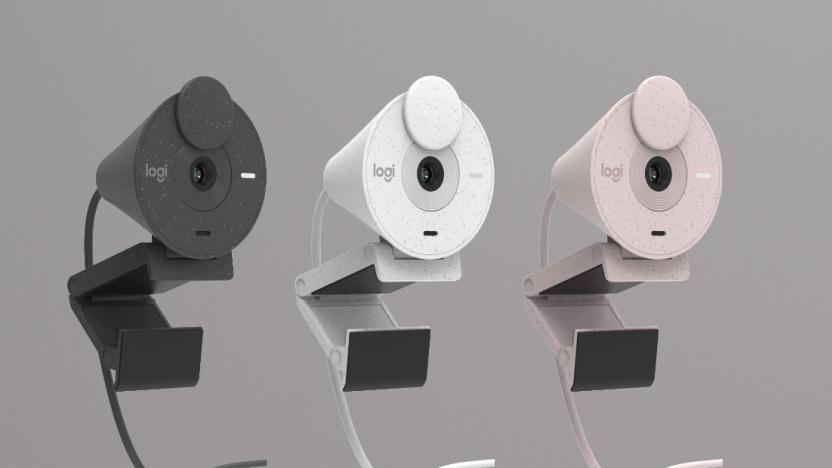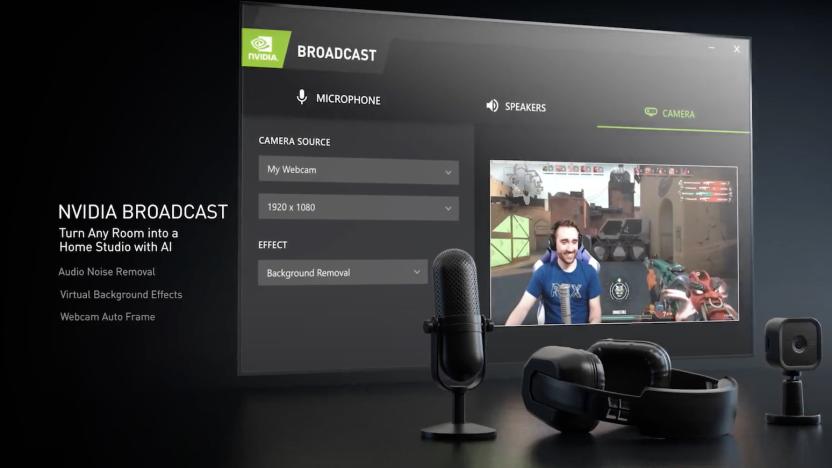noise reduction
Latest

Logitech's Brio 300 HD webcams offer auto light correction and noise reduction for $70
Logitech has unveiled a colorful, budget-oriented line of 1080p webcams, the $70 (£75) Brio 300 series.

NVIDIA Broadcast is kinda underrated
NVIDIA's Broadcast app has some pretty special tools for streamers, but you might have overlooked it. Here's a rundown of what it can do for your live recordings.

Logitech puts NVIDIA Broadcast features directly into its headsets and Blue mics
Logitech has announced that it's incorporating NVIDIA Broadcast directly into certain headsets and Blue microphones, with no need to run any NVIDIA apps.

NVIDIA wants to make video calls better with AI
Its Maxine platform can sharpen audio and video, and reduce bandwidth.

Pentax's top DSLR uses image stabilization to reduce noise
Given the moribund DSLR market, Ricoh wasn't about to mess around with the follow-up to its popular Pentax flagship, the K-3. Sure enough, the K-3 II retains the weather-proof body, fast 8.3 fps shooting speed and high-quality 24.4-megapixel APS-C-sized sensor of the last model, while getting some enticing new tweaks. First and foremost is the so-called Pixel Shift feature which uses in-body shake reduction to sample pixels four times, significantly reducing noise at low-light levels. While the feature only works for static subjects, it should be ideal for astrophotography and other applications.

CSR outs new Coach16 processor for high-end cameras, aims to kill video jaggies, noise
If you've ever cussed out your DSLR because your still shots or video had excessive aliasing, jello and noise, you might be happy to hear about the new Coach16 imaging chip from CSR. The new addition to the ex-Zoran line of imaging processors is aimed at DSLRs and mirrorless cameras, and for the cinema set brings 1080/60p HD video with 'super-resolution' RGB downscaling to eliminate aliasing caused by line-skipping. Still shooters would get "endless sustained burst" high frame-rate capability, multi-frame noise reduction for improved low-light shooting, USB 3.0 support, high resolution EVF capability and smart flash. The latter feature cleverly takes two pictures rapidly with and without a flash, then marries the best parts HDR style for the final image. We won't see any of that until it gets released in a new DSLR model, of course, but meanwhile, you can dream with the PR below the break.

Noise Free Wireless alleges Apple is tone deaf over sound reduction patent, files lawsuit to match
Apple faces litigation claiming that it's using patented technology all the time, often from small patent holding companies with dollar signs in their eyes. Noise Free Wireless has just filed a patent lawsuit against Apple whose allegations are considerably, well, louder. The firm maintains that it had been pitching its patented noise cancellation to Apple in periodic meetings between 2007 and 2010, only to watch as 1 Infinite Loop used Audience's technology for the iPhone 4 instead -- and supposedly handed some of Noise Free's work to a competitor. An Apple patent filed the same year borrows some of that work, Noise Free insists, in addition to the iPhone in question. Neither side is talking about the details to outlets like Macworld, although we'd be cautious about accepting either company's position at face value. However much Apple may protest its innocence regardless of circumstances, Noise Free certainly has a vested interest in retribution after losing out on such a big contract.

Noise Free Wireless creating a lot of noise over alleged Apple infringement
When you're the big target, it seems like everyone is shooting at you. Apple is now being sued by a Silicon Valley company by the name of Noise Free Wireless over alleged infringement of a patent for mobile phone noise-reduction technology. Noise Free Wireless says that the company first showed off its patented technology to Apple at meetings in 2007 with a number of increasingly technical and confidential meetings following until 2010, when Noise Free found that Apple was going to use technology from Audience (a rival) in future products. However, in June of 2010, Apple filed an application for a patent covering noise suppression. Noise Free Wireless is alleging that Apple reverse-engineered their "proprietary and confidential object code, determined Noise Free's noise reduction software, and measured and duplicated the signal traces from the circuit board and microcontroller," and then supplied that information to Audience. The lawsuit was filed on July 3, 2012 in the U.S. District Court for the Northern District of California, with Noise Free asking for damages for the alleged infringement as well as an invalidation of Apple's patent.

Siri may be iPhone 4S-only because of noise reduction tech
Siri has been in widespread use for four months, but so far Apple's "personal assistant" is still only available on one device, the iPhone 4S. We speculated that there weren't any technical reasons Siri couldn't work on some of Apple's other devices, and the jailbreak community later proved us right by porting Siri to the iPhone 4. AppleInsider did some digging and discovered there may be a technological reason Apple's kept Siri an iPhone 4S-only feature: noise reduction. The iPhone 4 incorporates noise reduction circuitry from a third-party vendor called Audience, and that circuitry lies separate from the A4 chip on the iPhone's logic board. The newer processor in the iPhone 4S (and possibly the iPad 2) incorporates a newer version of this noise-reduction circuitry within the A5 chip itself, reducing overall cost. Audience's noise reduction chip works similarly to how the human brain processes audio. By sampling audio from multiple sources (the iPhone's main microphone and the noise-cancelling mic), the Audience chip is able to filter out background noise and deliver only the user's voice, just like how your brain filters out noise in a crowded room to focus on a person talking to you. The newer noise reduction circuitry in the A5 chip is better at "far-field" noise reduction than the circuits in the iPhone 4. Essentially, the iPhone 4S can achieve the same or better noise reduction when held at arm's length that the iPhone 4 gets when held directly in front of a user's mouth. The implications for Siri use are obvious -- because of its less advanced noise reduction circuitry, Siri wouldn't function nearly as well on an iPhone 4 in an even moderately noisy environment unless you held it up to your ear and talked directly into the microphone. Despite having an A5 processor (and possibly including the newer noise reduction circuitry), Siri might not function well on an iPad 2 either, since the iPad 2 doesn't have a noise-cancelling microphone. Apple's product perfectionism often leads to scenarios where features that might technically work on a product wind up excluded because they don't work perfectly. I've run into this a few times with older gear; my old PowerBook G3 had no technical barriers to running OS X Panther or Tiger, for instance, but because it didn't run anything newer than OS X Jaguar well, Apple artificially restricted the device to Jaguar. Similarly, jailbreakers discovered ways to get video capture working on the iPhone 3G, but the results were rather lackluster compared to the officially-supported video recording on the iPhone 3GS and above. Even if Siri technically works on Apple's older iOS devices, if its performance doesn't work to Apple's satisfaction, we may never see Siri ported to the iPhone 4 or current iPads after all.

Ricoh CX3 gets back-illuminated CMOS sensor, much geek lust
Just like clockwork, here's Ricoh -- six months after its last CX series refresh -- with a new superzoom point-and-shooter to tempt us into breaking open those piggy banks. The package on offer is compelling: there's a new 10 megapixel back-illuminated CMOS sensor, an enhanced noise reduction algorithm borrowed from the GR Digital III, and a 3-inch 920k-dot LCD, while the 10.7x optical zoom lens (28-300mm in 35mm equivalence) is carried over from the CX2. 720p video recording -- fast becoming a standard feature in compact cameras -- is present and accounted for, with recording in 16:9 ratio available to the ubiquitous Motion JPEG format. The CX3 is arriving this month, with early prices of AU$499 ($441 in US currency) matching the cost of the current generation.

Jawbone brings new, very iPhone friendly headset to market
Jawbone has a new, feature rich Bluetooth headset called the ICON that is a nice match for the iPhone. New to this headset is a battery meter that displays on the iPhone, something the Apple Bluetooth headset also did. The Apple headset was quietly discontinued last spring after disappointing sales and reviews. The ICON lets you set custom tones and multiple voices to alert you to incoming calls, and a feature called MyTALK that allows you to control mini-apps that change the voices or language (Spanish, French, or German) and allows you to customize a button to call 411 or connect to other voice services. The newest Jawbone has also switched from the old proprietary power connector to a mini micro-USB cable, which is very welcome. The headset also claims to further reduce background and wind noise. The headset now comes in 6 color designs, including variations of black, gold, pearl and black laced with red. The newest addition to the Jawbone line is U.S. $100.00. Even though the new headset has iPhone-friendly features, it's available today at Verizon dealers, with other retailers to follow.

Yamaha's PSG-01S is the speakerphone version of a mullet
Following in ASUS' hot sweaty footsteps today comes Yamaha with a pair of Skype-certified USB speakerphones. The PSG-01S 'SoundGadget' (pictured) aspires to be everything to everyone, by automagically switching between an all-party speaker mode and dressed-up speakerphone duty, depending on its vertical orientation. The PJP-25URS, on the other hand, seems pretty well identical to its predecessor, the PJP-25UR, but for its support for Vista (and presumably Windows 7) machines. That means you still get a crazy twelve mic array and those fetching swing-out mic arms that corporate types must be simply in love with, given the distinct lack of changes. Both are powered via the USB connector, sport dedicated Skype controls, echo cancellation, and noise reduction, and are expected in Europe and the US this month. %Gallery-73419%

HIS iClear claims to reduce noise, really just fills an empty PCIe slot
If you've been hankering for a good dose of snake oil, we've found something sure to satisfy. The HIS iClear card is marketed as a device that rides shotgun with your graphics card and "provides up to a 10-percent increase in signal-to-noise ratio performance." From what we can gather, this mostly barren piece of kit is supposed to reduce noise generated by your graphics card (or something to that effect), but considering that NewEgg gives this thing away for free with GPU purchases, we feel our doubts about its effectiveness as justified.[Via BoingBoing]

Start-up debuts crazy new noise reduction tech for mobiles
A small company coming out of stealth mode at MWC this week is making some pretty wild promises about its new silicon -- and phone manufacturers must be buying the hype, because several have apparently have signed their names on the dotted line. The California start-up, Audience, is showing a 2.7 x 3.5mm chip that it claims uses some pretty wild algorithms to go beyond existing technologies like Motorola's CrystalTalk to reduce outgoing and incoming noise on calls by up to 25 decibels, enough to significantly reduce or entirely eliminate the sound of trains and yappy morons at Metro stops, car traffic, and loud music. The firm didn't disclose who its manufacturer partners were, only saying that there'd be further announcements later in the year. What's tha-- huh? No! We said, THERE'D BE FURTHER ANNOUNCEMENTS LATER IN THE YEAR.[Via New York Times]

smcFanControl 2.0 supports all Intel Macs
Hendrik Holtmann's smcFanControl, a free (but donation-friendly) program released under the GNU public license, just got upgraded to version 2.0. The new version, which now works with all Intel Macs, controls your fan speed while monitoring your computer's internal temperature. The new version sits in your menu bar (unlike version 1.0, which was a regular dock-based application) and introduces fan setting presets and the ability to detect whether you're running on A/C or battery power. This is a great way to keep your Mac cool while controlling the noise from your fan.Thanks, Mark Fleser.

Samsung BD-P1000 Blu-ray player firmware update available
Early adopting Blu-ray owners can now download, burn to disc, and install a patch for some of the issues that have plagued the Samsung BD-P1000 since its release -- but the "noise reduction" bug affecting picture quality is not one of them, yet. The firmware update 1.0 doesn't say exactly what it fixes, but the list of upgrades found so far is as follows: Fixes stuttering audio/video while viewing movies with DTS soundtracks Adds pillarboxing to 4:3 content on Blu-ray discs (instead of stretching it to widescreen), Improved load times Hourglass icon changed to colored dots Fixes reversed analog outs on affected players Adds DTS decoding for DVD content (like AVIA test disc) Of course, if you're on the list Samsung will simply send a disc for you to put in the player and upgrade, but why wait? Another release to fix the annoying noise reduction issue is expected "soon".[Via AVS Forum & Home Theater Blog, thanks for the tip Dave!]







